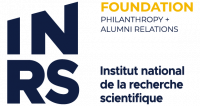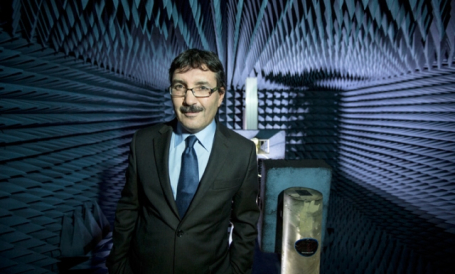New chairs in telecommunications
Two new research chairs in telecommunications are being launched this year at INRS, thanks to the Cyrille-Duquet endowment fund. Sonia Aïssa and Tayeb Dedni, both professors at the Institut national de la recherche scientifique’s Centre Énergie Matériaux Télécommunications, will hold these chairs. Their respective research programmes will receive annual funding of $50,000 over the next five years.
These two chairs are the result of a decision reached by the INRS Qualification Committee, which is led by the INRS Foundation. The proposal submitted by Professor François Légaré, Director of the Centre Énergie Matériaux Télécommunications research and training centre, was aimed at further developing scientific and technological advances and knowledge transfer in the fields of telecommunications.
Professor Sonia Aïssa is a specialist in wireless multimedia communications. She is particularly interested in the management of radio resources in wireless networks. Since June 2023, she has held the Research Chair in Sustainable Wireless Communications at INRS. We will be devoting a separate publication to her work shortly.
Trained in electrical engineering and a Fellow of the Institute of Electrical and Electronics Engineers (IEEE), Professor Tayeb A. Denidni focuses on antennas and radiofrequency systems. In particular, he is scientific manager of the INRS Radio Frequency Laboratory, an infrastructure that includes a shielded anechoic chamber and specialised equipment for the design and modelling of radio frequency components for wireless communications applications. He has just been awarded the new Research Chair in Advanced Antenna Systems for Millimetre-Wave Wireless Communications and Biomedical Sensors at INRS.
The $250,000 funding, to be combined with research grants, will enable him to develop a research programme that will, among other things, train a new cohort of scientists in next-generation 5G and 6G telecommunications and develop antennae with a range of biomedical applications. “Thanks to miniaturisation, I can imagine us, for example, designing antennae encapsulated in the human body to transmit and receive vital data,” he adds.
“Communications systems evolve from one generation to the next,” he says, “but we need to develop new antennas that will be able to pick up and transmit these communications of the future.” Frequency and bandwidth are important parameters in technological and industrial development. “Today’s systems allow people to be connected to each other, but future systems will enable new advances to be made in the field of connected objects, known as the ‘Internet of Things.’ We need broadband to transmit so much information. The development of millimetre-wave antennas is a way forward for wireless communications,” he says.
According to Prof. Denidni, the Chair will provide his team with the freedom to explore areas that granting agencies or corporations would not be prepared to fund. “We’re talking about fundamental research, about taking risks whether it works or not. It will allow us to dream, to imagine, to test unconventional things that may seem bizarre or like science fiction, but which could eventually lead to revolutionary technological innovations,” he says. What’s more, by enabling it to support more than a dozen students, the Chair will create “a critical mass of scientists highly trained at INRS in this field,” he adds.
He also plans to improve conditions for his students and continue his research collaborations with industrial partners. “My philosophy is to offer them the best possible conditions for their studies. Projects with industry contribute to their training and open up career opportunities for them, as well as increasing the funding available,” he says. “The happier our students are, the better they perform, so it’s a win-win situation,” concludes Prof. Denidni.
About the INRS Research Chair in Advanced Antenna Systems for Millimetre-Wave Wireless Communications and Biomedical Sensors
The Chair focuses on the design of advanced millimetre-wave antenna systems for future generations (5G and 6G) of wireless communications and biomedical sensors. The research will use new advanced materials to develop new antennas that will support future millimetre-wave wireless communications and biomedical applications. The aim is to develop a new programme of research excellence in the field of antennas for telecommunications, which can contribute to major innovations in cutting-edge high-tech sectors. This research programme will train students in antenna engineering, radiofrequency devices, telecommunications and biomedical sensors.
About the Cyrille-Duquet Fund
Since 1984, the Cyrille Duquet Fund has supported training and scientific and technological progress in the field of telecommunications at INRS. It bears the name of a Quebec merchant, politician and inventor, Cyrille Duquet (1841 - 1922), who is best known for his innovations in the field of telephony, such as processes to improve sound transmission and the invention of a handset on which the transmitter and receiver are located.

